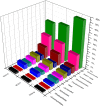Genetic diversity of bacterial communities and gene transfer agents in northern South China Sea
- PMID: 25364820
- PMCID: PMC4218858
- DOI: 10.1371/journal.pone.0111892
Genetic diversity of bacterial communities and gene transfer agents in northern South China Sea
Abstract
Pyrosequencing of the 16S ribosomal RNA gene (rDNA) amplicons was performed to investigate the unique distribution of bacterial communities in northern South China Sea (nSCS) and evaluate community structure and spatial differences of bacterial diversity. Cyanobacteria, Proteobacteria, Actinobacteria, and Bacteroidetes constitute the majority of bacteria. The taxonomic description of bacterial communities revealed that more Chroococcales, SAR11 clade, Acidimicrobiales, Rhodobacterales, and Flavobacteriales are present in the nSCS waters than other bacterial groups. Rhodobacterales were less abundant in tropical water (nSCS) than in temperate and cold waters. Furthermore, the diversity of Rhodobacterales based on the gene transfer agent (GTA) major capsid gene (g5) was investigated. Four g5 gene clone libraries were constructed from samples representing different regions and yielded diverse sequences. Fourteen g5 clusters could be identified among 197 nSCS clones. These clusters were also related to known g5 sequences derived from genome-sequenced Rhodobacterales. The composition of g5 sequences in surface water varied with the g5 sequences in the sampling sites; this result indicated that the Rhodobacterales population could be highly diverse in nSCS. Phylogenetic tree analysis result indicated distinguishable diversity patterns among tropical (nSCS), temperate, and cold waters, thereby supporting the niche adaptation of specific Rhodobacterales members in unique environments.
Conflict of interest statement
Figures






Similar articles
-
Spatial and vertical distribution of bacterial community in the northern South China Sea.Ecotoxicology. 2015 Oct;24(7-8):1478-85. doi: 10.1007/s10646-015-1472-2. Epub 2015 May 9. Ecotoxicology. 2015. PMID: 25956981
-
Gene transfer agent (GTA) genes reveal diverse and dynamic Roseobacter and Rhodobacter populations in the Chesapeake Bay.ISME J. 2009 Mar;3(3):364-73. doi: 10.1038/ismej.2008.115. Epub 2008 Nov 20. ISME J. 2009. PMID: 19020557
-
Spatial diversity of bacterioplankton communities in surface water of northern South China Sea.PLoS One. 2014 Nov 17;9(11):e113014. doi: 10.1371/journal.pone.0113014. eCollection 2014. PLoS One. 2014. PMID: 25402458 Free PMC article.
-
Bacterial diversity of water and sediment in the Changjiang estuary and coastal area of the East China Sea.FEMS Microbiol Ecol. 2009 Nov;70(2):80-92. doi: 10.1111/j.1574-6941.2009.00772.x. Epub 2009 Aug 28. FEMS Microbiol Ecol. 2009. PMID: 19780829
-
Ubiquity and diversity of heterotrophic bacterial nasA genes in diverse marine environments.PLoS One. 2015 Feb 3;10(2):e0117473. doi: 10.1371/journal.pone.0117473. eCollection 2015. PLoS One. 2015. PMID: 25647610 Free PMC article.
Cited by
-
Spatial and vertical distribution of bacterial community in the northern South China Sea.Ecotoxicology. 2015 Oct;24(7-8):1478-85. doi: 10.1007/s10646-015-1472-2. Epub 2015 May 9. Ecotoxicology. 2015. PMID: 25956981
-
Water masses influence bacterioplankton community structure in summer Kongsfjorden.Extremophiles. 2020 Jan;24(1):107-120. doi: 10.1007/s00792-019-01139-y. Epub 2019 Nov 2. Extremophiles. 2020. PMID: 31679078
-
Metagenomic Analysis of the Effect of Enteromorpha prolifera Bloom on Microbial Community and Function in Aquaculture Environment.Curr Microbiol. 2020 May;77(5):816-825. doi: 10.1007/s00284-019-01862-x. Epub 2020 Jan 11. Curr Microbiol. 2020. PMID: 31927597
-
The Protease ClpXP and the PAS Domain Protein DivL Regulate CtrA and Gene Transfer Agent Production in Rhodobacter capsulatus.Appl Environ Microbiol. 2018 May 17;84(11):e00275-18. doi: 10.1128/AEM.00275-18. Print 2018 Jun 1. Appl Environ Microbiol. 2018. PMID: 29625982 Free PMC article.
References
-
- Moran MA, González JM, Kiene RP (2003) Linking a Bacterial Taxon to Sulfur Cycling in the Sea: Studies of the Marine Roseobacter Group. Geomicrobiol J 20: 375–388.
-
- Newton RJ, Griffin LE, Bowles KM, Meile C, Gifford S, et al. (2010) Genome characteristics of a generalist marine bacterial lineage. ISME J 4: 784–798. - PubMed
-
- Zhao Y, Wang K, Budinoff C, Buchan A, Lang A, et al. (2008) Gene transfer agent (GTA) genes reveal diverse and dynamic Roseobacter and Rhodobacter populations in the Chesapeake Bay. ISME J 3: 364–373. - PubMed
Publication types
MeSH terms
Substances
LinkOut - more resources
Full Text Sources
Other Literature Sources

